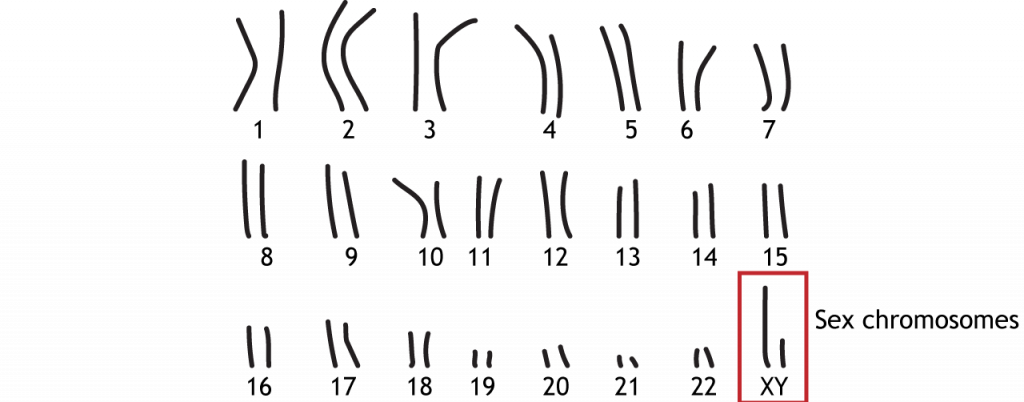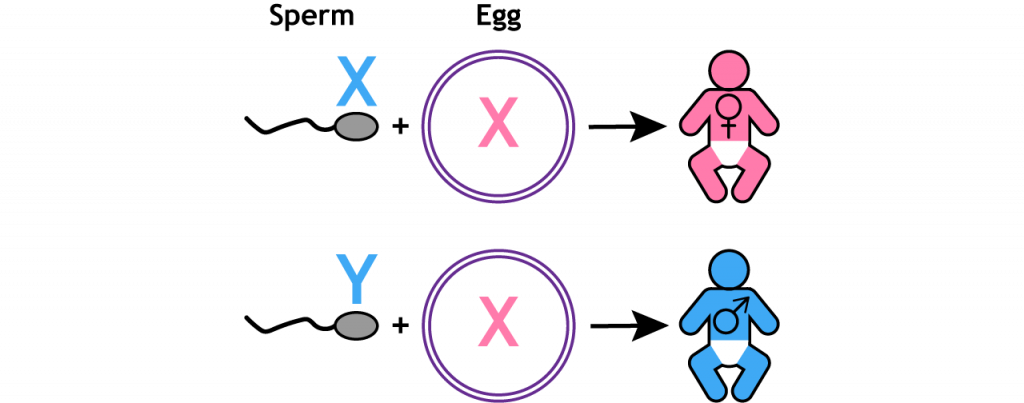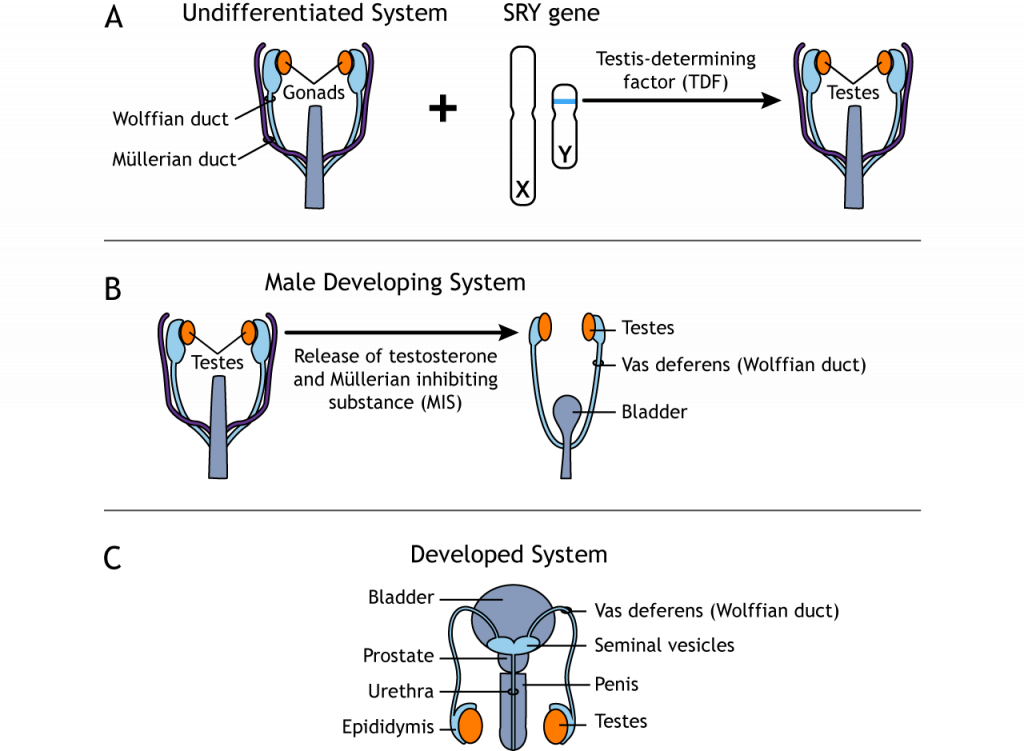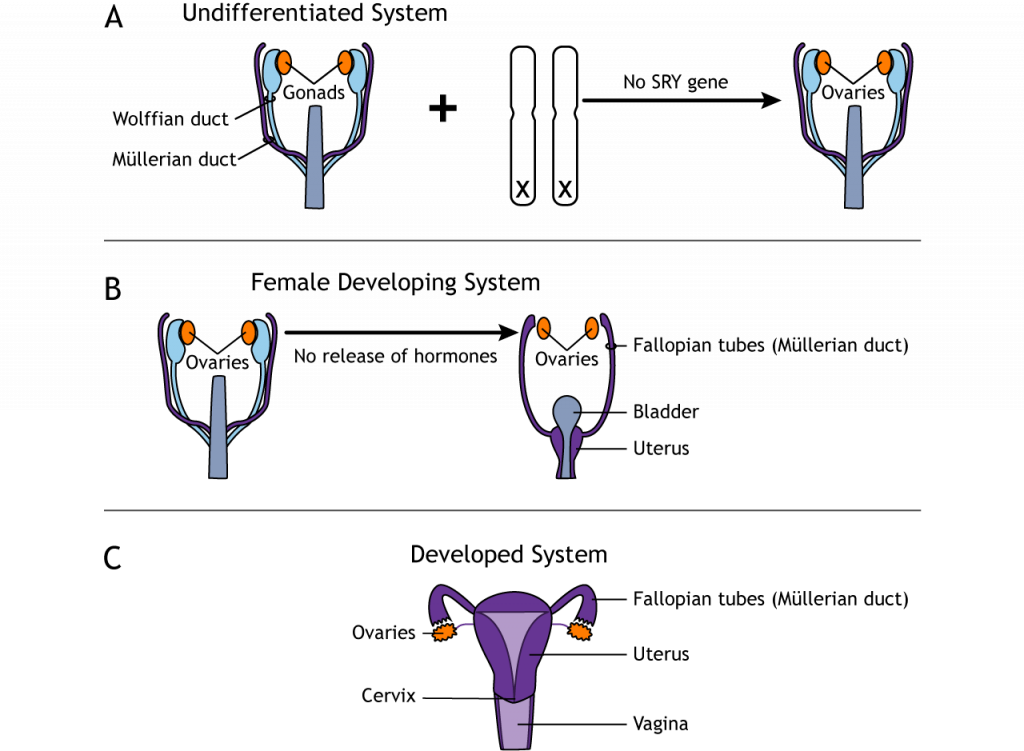52 Sexual Differentiation
Sexual differentiation is the process by which a person develops into either a male or a female. For the purpose of this chapter, the content will be based on a male/female binary to introduce the basic concepts of reproductive development. However, it is important to recognize that in real life, chromosomal sex, physical sex, and gender exist on a continuum and cannot always be simplified into a two-structure system.
Gender is a cultural variable with behaviors and attributes that are associated with being masculine or feminine and is determined by interactions between genes, hormones, life experiences, and cultural expectations.
During development, the body and the brain undergo either: A) feminization and de-masculinization or B) masculinization and de-feminization. In most cases, the differentiated brain will lead to behaviors that correspond to the differentiated gonads.

Chromosomal Sex
In humans, DNA is organized into 46 chromosomes. One set of 23 chromosomes comes from the mother and the other set comes from the father. Twenty-two pairs are called autosomal chromosomes. These chromosome are similar in length and have the same genes present at the same location regardless of if they are received from the mother or father. However, for all genes, the allele, or version, present for each gene may be different from each parent. The last pair of chromosomes is responsible for determining if an individual becomes a male or female; these are called the sex chromosomes. In humans, the sex chromosomes are named either X or Y.

Fertilization occurs when a sperm cell from the father fuses with an egg cell from the mother. All egg cells contain one X sex chromosome. Sperm cells contain either one X or one Y chromosome, which means chromosomal sex in humans is determined by the sperm. If a sperm carrying an X chromosome fertilizes an egg, the resulting fetus will be XX and a female, whereas if a sperm carrying a Y chromosome fertilizes an egg, the resulting fetus will be XY and a male.

Gonadal Differentiation
The presence of the Y chromosome signals for the formation of testes in the fetus. The Y chromosome is much smaller than the X chromosome (50 genes vs ~800 genes). There is a gene on the Y chromosome called the sex-determining region (SRY) of the Y chromosome. The SRY gene is required for masculinization of the embryonic gonads. Other genes on the Y chromosome are also important in sex determination and in male physiology, however we will focus on the SRY gene.
The SRY gene encodes for a protein called the testis-determining factor (TDF), which causes the embryonic gonads to differentiate into the testes. The testes then begin secreting both testosterone and a hormone called the Müllerian inhibiting substance (MIS). Testosterone causes Wolffian ducts to develop into the vas deferens, seminal vesicles, and epididymis. MIS causes the Müllerian ducts to degenerate. The presence of testosterone also results in the development of the prostate gland and penis.
Because XY males only have one copy of the X chromosome, they are more at risk for X-linked diseases.

In females, when the SRY gene and secreted hormones are absent, the gonads differentiate into the ovaries, the Müllerian ducts develop into the fallopian tubes, uterus, and vagina, and the Wolffian ducts degenerate.

Chromosomal Abnormalities and Effects on Sex
There are a number of disorders that result from chromosomal abnormalities. In Klinefelter Syndrome, individuals have an XXY genotype. Due to the presence of a Y chromosome, individuals with Klinefelter Syndrome have a “male” appearance. The additional X chromosome causes the individual to have less body hair, small testes, wide hips, long arms and legs, more breast tissue, and a female pubic hair pattern. The additional X chromosome causes many individuals with Klinefelter’s Syndrome to be infertile.
In Jacobs Syndrome, also called XYY Syndrome, individuals have an XYY genotype. Again, due to the presence of a Y chromosome, these individuals typically have a “male” appearance. Individuals may also be taller than average and have an increased risk of learning disabilities. Psychological studies indicate that individuals with XYY Syndrome may have difficulty with impulse control and emotional regulation. Historically, increased testosterone is correlated to increased aggressive behavior in incarcerated males with XYY Syndrome.
In Trisomy X, also called XXX Syndrome, individuals have an XXX genotype. These individuals have a “female” appearance. Fewer than 10% of individuals that have XXX Syndrome are aware that they have it. Symptoms include learning disabilities, wide-spaced eyes, and increased height. Individuals have an increased risk for early menopause.
In Turner Syndrome, individuals have an XO genotype. The “O” indicates the absence of a chromosome, therefore rather than 2 sex chromosomes, individuals with Turner Syndrome only have 1 X chromosome. The lack of Y chromosome leads to these individuals having a “female” appearance. Other symptoms associated with Turner Syndrome include short stature, webbed neck, low-set ears, and a receding jaw. Due to only having one X chromosome, ovaries typically do not form, or form abnormally, and breasts do not develop. Hormone therapy is necessary for the development of a menstrual period and breasts. There is not a corresponding YO genotype, because at least one X chromosome is necessary for life.
Key Takeaways
- During development, the body and the brain undergo either A) feminization and de-masculinization or B) masculinization and de-feminization.
- The sex chromosomes X and Y make up one pair of the 23 total pairs of chromosomes in humans.
- Females are genetically XX and males are genetically XY.
- The SRY gene on the Y chromosome is responsible for the development of the male reproductive system.
- In the absence of hormones, the female reproductive system develops.
Attributions
Portions of this chapter were remixed and revised from the following sources:
- Foundations of Neuroscience by Casey Henley. The original work is licensed under a Creative Commons Attribution-NonCommercial-ShareAlike 4.0 International License
Media Attributions
- Gender Icons © Casey Henley is licensed under a CC BY-NC-SA (Attribution NonCommercial ShareAlike) license
- Chromosomes © Casey Henley is licensed under a CC BY-NC-SA (Attribution NonCommercial ShareAlike) license
- Fertilization © Casey Henley is licensed under a CC BY-NC-SA (Attribution NonCommercial ShareAlike) license
- Male Gonad Differentiation © Casey Henley is licensed under a CC BY-NC-SA (Attribution NonCommercial ShareAlike) license
- Female Gonad Differentiation © Casey Henley is licensed under a CC BY-NC-SA (Attribution NonCommercial ShareAlike) license
combination of a male sex cell (sperm) with a female sex cell (egg)

